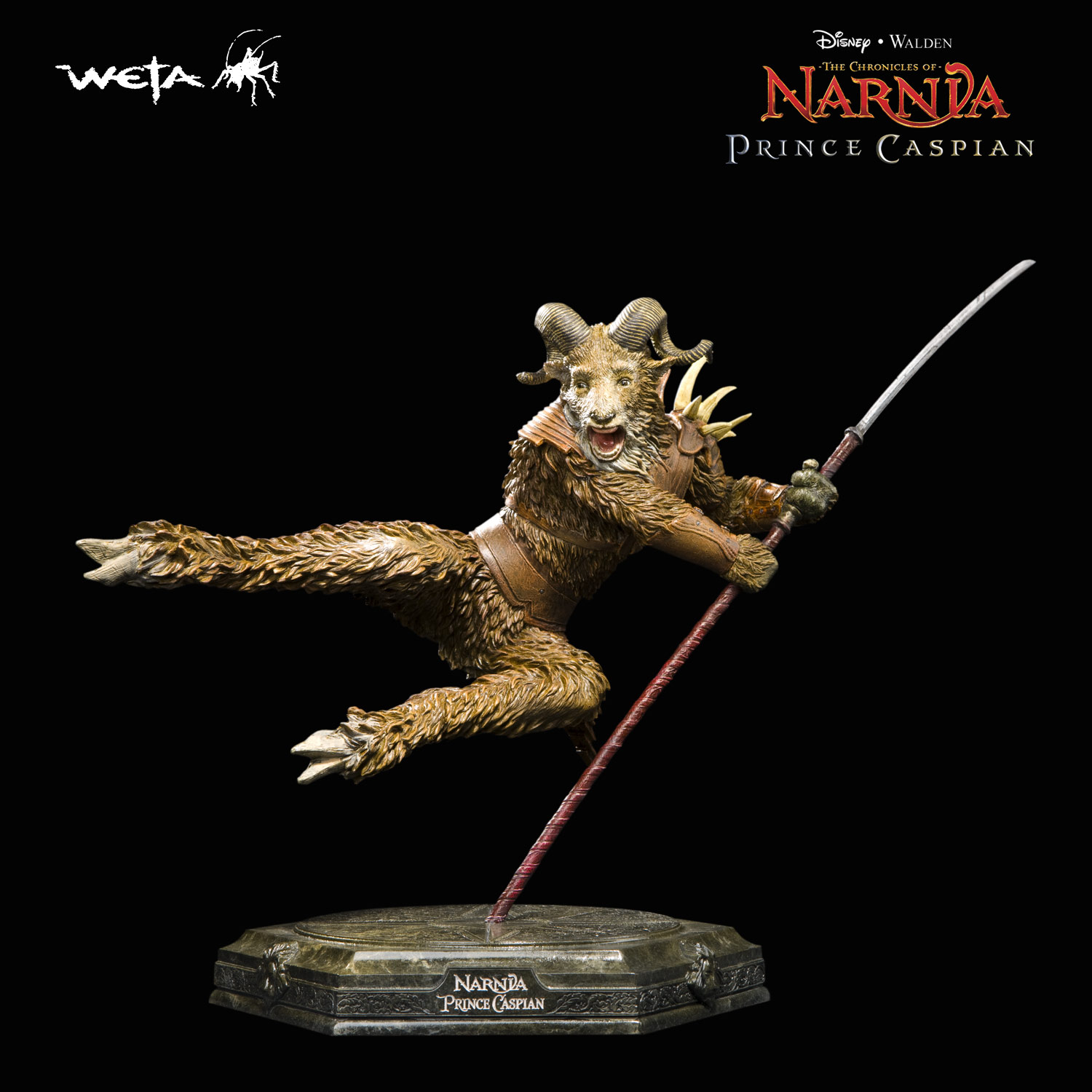They are classic, epic literary fantasies, beloved for decades — but there’s no ring and no Frodo. The tales enlist images from children’s imaginations, empowering kids and making older fans feel young again — but there’s no lightning-scarred wizard. The newest highly anticipated book-to-movie franchise is also being overseen by one of the most successful directors in recent Hollywood history — but you’ve probably never heard of him.
“There is the epic nature of the ‘Lord of the Rings’ films, and there’s a sort of child-friendly aspect of ‘Harry Potter,’ and there’s a world that exists in between,” grins 40-year-old New Zealand director Andrew Adamson, pushing back the scraggly blond hair spilling over his simple red T-shirt. Sporting a mug reminiscent of Steve Buscemi and an unkempt style like that of fellow director Peter Jackson, Adamson is positively giddy as the first of his epic “Chronicles of Narnia” films nears release.
“It’s a fantasy movie with children that takes itself seriously,” Adamson says of “The Lion, the Witch and the Wardrobe,” due to inspire “Potter”-type lines when it opens December 9. “To me, Narnia is a real place these children go.”
With a cast that features several unknown youngsters angling to become the next Daniel Radcliffe, Adamson feels compelled to introduce his stars. “William Moseley plays Peter Pevensie,” he says. “I wished Willie was my big brother [when I met him]; he just had that warmth.
“With Anna Popplewell, who plays Susan,” he marvels, “she’s just very, very smart, very sassy. She’s got a real sort of good sarcastic edge to her, and she has a real internal strength, and that was something that was important to me in Susan.
“Skandar Keynes plays Edmund. I actually almost cast him off a photograph, because he had these incredible, wonderful dark eyes. He looked like he could be Georgie Henley’s older brother, but he also is as mischievous as the real Edmund is in the movie.
“And then Georgie Henley, who plays Lucy,” he smiles, “was 8-years-old when we started this movie and just caught my eye immediately on tape. She was talking about a book she was reading, and she said it’s very sad, and her whole countenance changed. You could tell she was completely empathizing with the characters in the book, and I saw … she was just every bit Lucy. She was bold, and she was naive, and she was innocent.”
If you’re among the more than 60 million who’ve read C.S. Lewis’ “Narnia” books, those descriptions alone might get you sleeping on the sidewalk outside your local megaplex. For those who’ve somehow missed the 50-year-old phenomenon, however, Adamson is more than happy to geek out with a little “Narnia” 101.
“It starts as a small family drama with these four children in war-torn England during World War II,” he begins. “They’re evacuated out to the country because of their worries of bombing, and while there the youngest girl, Lucy … while playing hide-and-seek, steps through a wardrobe, and while she backs through the wardrobe she steps into the land of Narnia, which is a fantasy land that is in the hold of the White Witch,” played by Tilda Swinton (“Adaptation,” “Vanilla Sky”).
Once the children step through the world’s coolest closet, they discover a land filled with wonder, adventure and peril. “[The Witch has] basically been in control of Narnia for 100 years of winter, and ultimately it’s the story of these four children’s epic journey to overcome the odds of Narnia to defeat the White Witch, and to bring the true king of Narnia, Aslan, back into power.”
To bring the powerful king (who just happens to be a talking lion) to life on the big screen, Adamson and his enormous special-effects crew employed technology that didn’t exist as recently as two years ago. And just as much concern went into casting the right vocal talent, which resulted in the firing of veteran actor Brian Cox (“X-Men 2”) after he’d recorded much of Aslan’s dialogue.
“You just had to go with your gut as to whether it worked or not,” Adamson remembers. “Brian and I both talked about it, and I felt there was a couple of things [wrong.] … [Aslan is] a difficult character. He’s an omnipotent character, and yet he has to be very accessible.”
The move paid off when Oscar-nominated star Liam Neeson pursued the vacancy enthusiastically. “Liam actually came to me wanting to do the part. … He really does have a warmth and resonance, as well as sort of this great power that he can quickly shift to. … Aslan is not a tamed lion, and Liam is definitely able to convey that.”
Going beyond the voice, Adamson remembers many other reasons why Aslan’s realization was a grueling labor of love. “Aslan was very difficult because he was a photo-real lion, and the flowing mane, the hair interaction, the reality of all the facial musculature was very difficult,” he says, shaking his head. “Though in some ways, what I call the hybrid creatures — half-man, half-beast kind of creatures — were more difficult.
“The centaurs are examples: Their upper-bodies are men and their lower bodies are horses,” he says of the wise, loyal creatures. “Finding, first of all, the right aesthetic balance between the horse body and the man body without the man body growing too big was a challenge. But on top of that, in some shots, we have a real horse with a CG upper-body. In other shots we have a real horse with a real upper-body that we’d merge together. Other shots we would have a real upper-body and a CG horse, and then in some shots they’re totally computer-generated.”
Similar technology was used to give birth to one potential breakout character, the flute-playing faun who assists the Pevensie children. “Mr. Tumnus, he’s basically a human upper-body with a goat lower-body, goat legs. That was sort of challenging. The actor had to move in a way that looked like he was walking on goat legs, which James McAvoy kind of perfected. … The main thing was to be walking on the balls of your feet … to be kind of on tip-toes so it threw your balance slightly off, and it made it work very well, and you had more up-and-down motion. We figured that because the fawns only have small hooves, they would have to continuously move to maintain their balance, so you kind of kept a fidgety footstep going on.”
Adamson and his crew created an entire world of characters — good and bad, heart-tugging and smile-inducing — including one beloved family who possess the wisdom and charms of a blue-collar Yoda. “The beavers, Mr. and Mrs. Beaver … are characters in the film who travel all the way through the journey with the kids,” Adamson insists. “You don’t want people thinking, ‘Oh, those are great CG beavers’; it’s kind of like, ‘Oh, that’s Mr. Beaver, he’s a guy who just hangs out and does his stuff with Peter.’ ”
With this first “Narnia” adventure finally in his rearview mirror, Adamson has begun focusing his loving glance on the next of what he hopes will be seven movies — one for each book of the series. “Yeah, this is the rest of my life,” he smiles, half-joking. “I suspect that I will do the next one, and probably be involved in all of them.”
Despite some fans’ objections, however, the movies will not be produced in the order of the books’ publications. “We’re going to keep it in a chronological order [in regard to the storyline],” Adamson said. “We’ve got the four children, who take part in ‘Prince Caspian.’ We have to make that film before Skander ends up with a mustache.”
To fans of the books, Adamson makes one important promise: Support the movies, and he’ll continue to support their wishes. “I don’t think there’s a need to combine them,” he says of “Lemony Snicket” notions to merge the volumes. “At one point I looked at the idea of taking ‘[The Voyage of the] Dawn Treader’ and putting all four kids in ‘Dawn Treader,’ but I think the books are too loved as they are. And I, myself, felt a slight betrayal to my own childhood memories in thinking about doing that.”
So if you see “Wardrobe,” prepare yourself for a taste of “Potter,” a tinge of “Rings” and a heaping helping of fidelity to a wholly original series. What you won’t find, however, are any signs that the self-professed geek behind the camera is the same director who infused the massively popular “Shrek” films with their sense of irreverent goofiness.
“There’s humor, obviously, in the film, but it’s character humor. It comes from who the characters are,” Adamson insists, laughing as he makes the “Narnia” fans one last promise. “Aslan doesn’t fart.”


